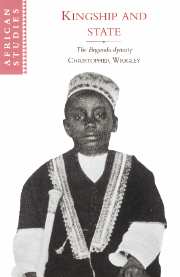Book contents
- Frontmatter
- Contents
- List of illustrations
- Preface
- Notes on language
- List of abbreviations
- 1 Preamble
- 2 The story and its making
- 3 Introduction to myth
- 4 Introduction to Buganda
- 5 The remoter past
- 6 Genesis
- 7 The cycle of the kings
- 8 Fragments of history
- 9 Foreign affairs
- 10 The making of the state
- 11 Reflections
- Notes
- Bibliography
- Index
- Other books in the series
4 - Introduction to Buganda
Published online by Cambridge University Press: 12 January 2010
- Frontmatter
- Contents
- List of illustrations
- Preface
- Notes on language
- List of abbreviations
- 1 Preamble
- 2 The story and its making
- 3 Introduction to myth
- 4 Introduction to Buganda
- 5 The remoter past
- 6 Genesis
- 7 The cycle of the kings
- 8 Fragments of history
- 9 Foreign affairs
- 10 The making of the state
- 11 Reflections
- Notes
- Bibliography
- Index
- Other books in the series
Summary
The explorers who claimed to have discovered the interior of East Africa during the third quarter of the nineteenth century were following routes that were already familiar to Muslim (Arab and Swahili) merchants from the coast, and before that had been trodden by a great many parties of Africans taking ivory and slaves to sell there. So the journey of Captains Speke and Grant to Buganda in 1861–2 took them along the great caravan trail that led through the middle of what is now Tanzania and then north-west to the kingdom of Karagwe in the far corner of the modern state. It was a roundabout route, but for several generations Karagwe had been the entrept for the trade of the rich region between the Lakes. It was there that King Muteesa's great-grandfather had arranged the sale of his country's ivory in exchange for dark blue Indian cloth, though it was not until his father's time, in the late 1840s, that the first Arab merchants passed through on their way to the Ganda court, bringing back to the coast, and thus to Europe, news of a powerful monarch whose favour could unlock the commerce of a region rich in ivory and perhaps in much else besides. It was this road that the British travellers were following, though for them the immediate attraction of Buganda was that they believed it to hold the key to the mystery of the Nile source.
- Type
- Chapter
- Information
- Kingship and StateThe Buganda Dynasty, pp. 57 - 68Publisher: Cambridge University PressPrint publication year: 1996

